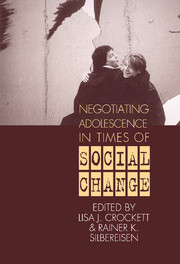Book contents
- Frontmatter
- Contents
- Contributors
- Preface
- 1 Social Change and Adolescent Development: Issues and Challenges
- Part I Models of Social Change Effects
- Part II Social Change and Adolescent Transitions
- Part III Social Change and Adolescents' Social Contexts
- 9 Adolescent Peer Relations in Times of Social Change
- 10 Life Course Dynamics and the Development of New Relations Between Generations
- 11 A Neighborhood-Level Perspective on Social Change and the Social Control of Adolescent Delinquency
- 12 Social Change and the “Social Contract” in Adolescent Development
- Part IV Implications of Social Change for Adolescent Health and Well-Being
- Part V Interventions: Promoting Healthy Development in Times of Social Change
- Endnotes
- Index
10 - Life Course Dynamics and the Development of New Relations Between Generations
Published online by Cambridge University Press: 26 January 2010
- Frontmatter
- Contents
- Contributors
- Preface
- 1 Social Change and Adolescent Development: Issues and Challenges
- Part I Models of Social Change Effects
- Part II Social Change and Adolescent Transitions
- Part III Social Change and Adolescents' Social Contexts
- 9 Adolescent Peer Relations in Times of Social Change
- 10 Life Course Dynamics and the Development of New Relations Between Generations
- 11 A Neighborhood-Level Perspective on Social Change and the Social Control of Adolescent Delinquency
- 12 Social Change and the “Social Contract” in Adolescent Development
- Part IV Implications of Social Change for Adolescent Health and Well-Being
- Part V Interventions: Promoting Healthy Development in Times of Social Change
- Endnotes
- Index
Summary
For them, modernity is basically a break with the ligatures of former times. Gone is the idyllic past with its holy shudders. The exit of man from his dependence, brought on by himself, is at the same time his exit from the nest warmth of stable human relations in fixed corporative structures. All fixed deep-rutted relationships are dissolved. And what are they replaced by? Not much … At the end of this world without ligatures, the false gods are not far off. They have led astray many and some followed them even to Jonestown. (Dahrendorf, 1994, p. 424).
The Change in Forms and Course of Life
According to Dahrendorf (1994), Giddens (1988), and Beck (1986), the options of choice and opportunities have increased clearly for the individual in modern times to find a satisfying way of life, to fulfill oneself, and to live the way one wants regardless of tradition and family background. This is true especially for the modern welfare state, which secures the individual against life risks to a high degree. That these freedoms have to be paid for with a high price in the area of private life with the loss of security and stability of private relationships is the initial thesis of many authors (Etzioni, 1993; Berger & Luckmann, 1995).
These recently won freedoms are also to be found in the new scripts of life and biographies (Buchmann, 1991), which have become less closed and unitary and open more different courses. Several names have been found for this newopen status of the life course such as destandardization of the life course or individualization (Giddens, 1991).
- Type
- Chapter
- Information
- Negotiating Adolescence in Times of Social Change , pp. 157 - 177Publisher: Cambridge University PressPrint publication year: 1999



